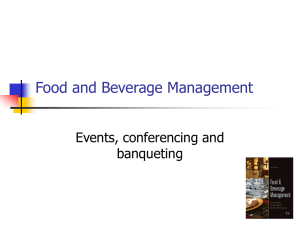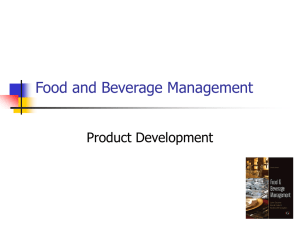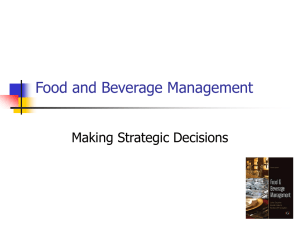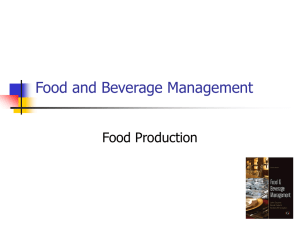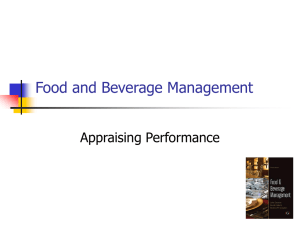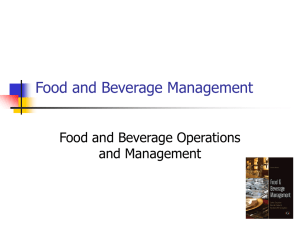Food and Beverage Managment 3rd Edition 2011
advertisement
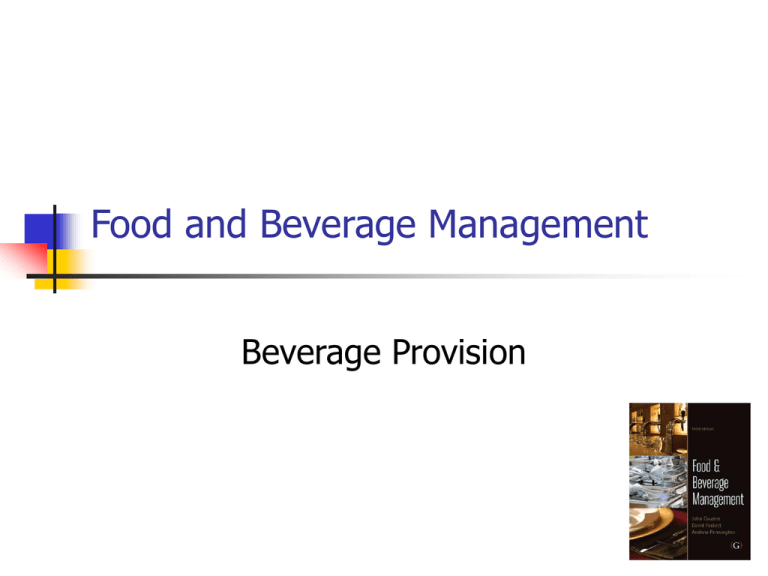
Food and Beverage Management Beverage Provision Effects of alcohol Depresses the brain and nerve function Affects a person’s judgement, self-control and skills The four general stages of becoming drunk: Stage 1: Happy (relaxed, talkative and sociable) Stage 2: Excited (erratic and emotional movement and thinking affected) Stage 3: Confused (disorientated, loud, out of control) Stage 4: Lethargic (unable to stand, talk or walk) © 2011 Cousins et al: Food and Beverage Management, 3rd edition, Goodfellows Publishers Safe, sensible drinking Small amount of alcohol does no harm and can even be beneficial The more you drink the greater the health risks Increasing concern about higher levels of alcohol consumption Various initiatives being tried Those who sell and serve alcoholic beverages being encouraged to become more responsible Important members of staff are aware of restrictions on sale of alcohol © 2011 Cousins et al: Food and Beverage Management, 3rd edition, Goodfellows Publishers Alcoholic strength Two main scales: 1. 2. Organisation Internationale Métrologie Légale (OIML) Scale (European): range 0% to 100% alcohol by volume American Scale (USA): range 0° to 200° Liquid measured as 40% alcohol by volume has 40 per cent of the contents as pure alcohol © 2011 Cousins et al: Food and Beverage Management, 3rd edition, Goodfellows Publishers Approximate alcoholic strength: [insert here figure ] © 2011 Cousins et al: Food and Beverage Management, 3rd edition, Goodfellows Publishers Safe, Sensible Limits UK has set the limits at: 21 units spread throughout the week for men 14 units spread throughout the week for women (excluding pregnant women) Drinking in excess of these limits is likely to be damaging to health © 2011 Cousins et al: Food and Beverage Management, 3rd edition, Goodfellows Publishers Unit of alcohol One units of alcohol is equal to 10 millilitres (liquid) or 8 grams (weight) of alcohol Roughly equivalent to: ½ pint of ordinary beer or lager one glass of wine (125 ml) one glass of sherry (50 ml) one measure of vermouth or other apéritif (50 ml) one measure of spirits (25 ml) © 2011 Cousins et al: Food and Beverage Management, 3rd edition, Goodfellows Publishers Calculating alcohol intake for wine: Specific percentage of alcohol times the amount in litres, equals the units of alcohol per bottle. For example: Wine at 12% alcohol by volume x 0.75 litre bottle = 9 units per 75 cl bottle This 75 cl bottle of wine will give 6 x 125 ml individual glasses of wine and each glass will contain 1.5 units of alcohol (9 units in the whole bottle divided by the 6 glasses) © 2011 Cousins et al: Food and Beverage Management, 3rd edition, Goodfellows Publishers Example for other drinks: Lager at 5% alcohol x 0.50 litre measure = 2.5 units per half litre measure Spirit at 40% alcohol x 0.025 litre (25ml) measure = 1 unit per 25 ml measure Sherry at 18% alcohol x 0.05 litre (50 ml) measure = 0.9 unit per 50 ml measure © 2011 Cousins et al: Food and Beverage Management, 3rd edition, Goodfellows Publishers Types of wine and drinks lists Bar and cocktail, lists Restaurant lists After meal drinks lists (digestifs) Banqueting and events lists Room service lists Lounge service lists © 2011 Cousins et al: Food and Beverage Management, 3rd edition, Goodfellows Publishers Hot beverages Tea Coffee Chocolate © 2011 Cousins et al: Food and Beverage Management, 3rd edition, Goodfellows Publishers Teas Can include General basic teas More specialise teas such as: Darjeeling, Earl Grey, Jasmine Iced teas Flavoured teas (tisanes) © 2011 Cousins et al: Food and Beverage Management, 3rd edition, Goodfellows Publishers Coffee brewing methods Pour through filter machine Single filter Turkish/Greek/Arabic coffee Jug and plunger/cafetière © 2011 Cousins et al: Food and Beverage Management, 3rd edition, Goodfellows Publishers Espresso based coffee styles Espresso Espresso doppio Café crème Espresso ristretto Americano Espresso macchiato Espresso con panna Cappuccino Caffè (or café) latté Flat white Latte macchiato Caffè mocha (or mochaccino) © 2011 Cousins et al: Food and Beverage Management, 3rd edition, Goodfellows Publishers Non-alcoholic bar beverages Five main groups: 1. 2. 3. 4. 5. Aerated waters: e.g. bitter lemon, cola Natural spring/mineral waters Squashes Juices Syrups such as: Cassis (blackcurrant) Grenadine (pomegranate) © 2011 Cousins et al: Food and Beverage Management, 3rd edition, Goodfellows Publishers Shift in consumer demand for bottled waters Reasons for this include: Environmental and sustainability concerns leading to higher customer demand tap water Emergence of commercial water filter systems © 2011 Cousins et al: Food and Beverage Management, 3rd edition, Goodfellows Publishers Contents of wine and drink lists Usually listed in the order consumed: Apéritifs Cocktails Spirits and associated mixers Wines – sparkling and still Beers, cider, perrys Aerated waters and squashes Digestifs Speciality Coffees © 2011 Cousins et al: Food and Beverage Management, 3rd edition, Goodfellows Publishers Listing of wines By place of origin (geographical) By type By grape © 2011 Cousins et al: Food and Beverage Management, 3rd edition, Goodfellows Publishers General information given – wines: Bin number Name of wine Country and area of origin Quality indication (e.g. AOC, Qmp etc.) Shipper Château/estate bottled Varietal (grape type(s)) Vintage Alcoholic strength ½ bottle, bottle, magnum Price Supplier Descriptive notes as appropriate © 2011 Cousins et al: Food and Beverage Management, 3rd edition, Goodfellows Publishers Information on other drinks: Type of drink Brand name if appropriate Style (sweet, dry, etc.) Description, for example for cocktails Alcoholic strength in percentage by volume as appropriate © 2011 Cousins et al: Food and Beverage Management, 3rd edition, Goodfellows Publishers Pricing Cost plus Rate of return Market orientated Fixed mark-up BYOB and corkage charges © 2011 Cousins et al: Food and Beverage Management, 3rd edition, Goodfellows Publishers Purchasing Using main or a variety of suppliers Also need to take into account: Cost of purchasing Determining stock levels © 2011 Cousins et al: Food and Beverage Management, 3rd edition, Goodfellows Publishers Purchasing wines Fine wine merchant/distributor (Branded) wine merchant/distributor Brewery wine division Direct from producer Wine retailers Wine clubs Internet Wine fair Auction rooms Brokers Tastings En primeur © 2011 Cousins et al: Food and Beverage Management, 3rd edition, Goodfellows Publishers Maintain quality of wine stock Regular tasting, or evaluation, of wine and other drinks is carried out to: Develop learning from experience Help in the assessment of the quality of a wine in terms of value Monitor the progress of a wine that is being stored Assist in the description of a wine when explaining its qualities or deficiencies to customers Provide a record of wines tasted © 2011 Cousins et al: Food and Beverage Management, 3rd edition, Goodfellows Publishers Professional approach to tasting Three key stages: 1. 2. 3. Recording the details of each individual wine Looking at, smelling and tasting the wine Recording the findings © 2011 Cousins et al: Food and Beverage Management, 3rd edition, Goodfellows Publishers Beverage control ‘books’ © 2011 Cousins et al: Food and Beverage Management, 3rd edition, Goodfellows Publishers Determining cost of sales The traditional approach Measuring the value of stock at cost price The issues to individual outlets are also costed at selling price This is a very laborious process © 2011 Cousins et al: Food and Beverage Management, 3rd edition, Goodfellows Publishers Determining cost of sales An alternative method Par stock levels set for individual outlets (by number of items) All that is important for control is the cost of actual sales Therefore, only the cost of goods issued to the outlets needs to be calculated Stock levels are monitored by quantity © 2011 Cousins et al: Food and Beverage Management, 3rd edition, Goodfellows Publishers
